Alicia Vikander Tulip Fever
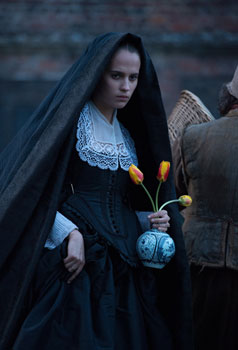
Set During Tulip mania of 17th Century Amsterdam
Cast: Alicia Vikander, Christoph Waltz, Zach Galifianakis, Cara Delevingne, Dane DeHaan
Director: Justin Chadwick
Genre: Drama, Romance
Rated: MA15+
Running Time: 105 minutes
Synopsis: In 17th Century Amsterdam, an orphaned girl (Alicia Vikander) is forcibly married to a rich and powerful merchant (Christoph Waltz) – an unhappy 'arrangement" that saves her from poverty. After her husband commissions a portrait, she begins a passionate affair with the painter (Dane DeHaan), a struggling young artist. Seeking to escape the merchant's ever-reaching grasp, the lovers risk everything and enter the frenzied tulip bulb market, with the hope that the right bulb will make a fortune and buy their freedom.
Tulip Fever
Release Date: November 23rd, 2017
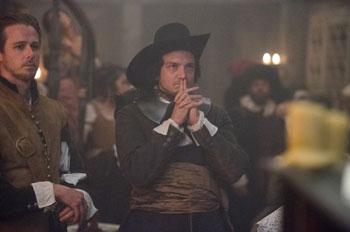 About The Production
About The Production
The Genesis of the Film
Producer Alison Owen read the book Tulip Fever before it was even published and instantly bought the option. Having read a review of a factual book about the tulip fever of 1630s Amsterdam, she was fascinated by the concept of this mania and how 'it was the first example of the futures market and it was the first time that money was represented in metaphorical terms, in certificates, and tulip bulbs. I thought it sounded really fascinating, and as a producer you're always looking out for interesting backdrops for a story." She continues: 'A few months later I read a round up of what was being published in the New Year, and it mentioned that Deborah Moggach's novel Tulip Fever was coming out in May – a love story set in Amsterdam. I thought, I wonder if somebody's done the job for me, of finding a story to set against this backdrop…When I read the manuscript, I felt, in story terms, that I'd discovered -The Beatles', because it's such a great story…it's engineered to perfection, it's got great characters and was obviously of the time."
Within forty-eight hours of buying the option and sending it out, Owen had offers from Stephen Spielberg, Ridley Scott and Harvey Weinstein. Due to a series of obstacles, however, Owen took another fifteen years finally to go into production on the film, which she now sees as a positive setback: 'I was devastated when the film fell through the first time, because I'd felt that it was very much of the zeitgeist. Little did I know that it was actually becoming more and more zeitgeisty, if that's possible! The recession that we were experiencing when I first optioned this book was only the start of a bunch of financial consequences that we've been suffering globally ever since. If anything, it's a lot more relevant now then it was then."
Fifteen years later, her tenacity and vision finally paid off and in May 2014 the film went into production.
From Book to Script to Screen
For Alison Owen, Deborah Moggach's novel was a fascinating read: 'It's got so many layers it's hard to condense them, but that's the challenge, trying to fit everything into the script. It's a fantastic love story set against this amazing backdrop, and at the heart of it, it's a metaphor about love, lust and passion. The most highly valued tulips were the ones that broke into colors and stripes and were called breakers. At the time, they had no idea why that happened, but in actuality it was because of a virus. Ironically, the most valuable bulbs were the ones that were diseased, carrying the seeds of their own destruction, ultimately rotting. Of course that's a wonderful metaphor for the adulterous love that takes place in the novel. It is this wonderful love, this great passion, but because it's an elicit love, it also carries the seeds of its own destruction."
She continues: 'Another thing I loved about Deborah's novel is the way that you love everyone in it. That's really hard to pull off and that was the hardest thing to pull off in its transition to script form. You love all these people, yet none of them at the expense of each other. That's much easier to do in a book where you can have an internal narrative as Deborah does, telling the story from each character's point of view. In an adaptation it's much harder to do that. We got there in the end, but it's so delicate, it's like a house of cards."
Alicia Vikander, who plays Sophia had heard about the project and was keen to be a part of it. She explains: 'I knew it was a Tom Stoppard script and I'd worked with him on -Anna Karenina'. I got hold of the script because I'd heard such good things about it and I just fell in love with it. It's a costume drama, but it's the wit and the pace and thrill that made me cry and laugh. It could have been a farce, but instead it's so intelligent. It's very difficult to find great female roles and in this both the female lead roles are very complex and diverse characters." She continues: 'Tom's script has so much subtext and nuance – it's just quite brilliant."
For Dane DeHaan who plays Jan Van Loos, it was the way the script resonated with our contemporary world that initially drew him in: 'It was the first stock market crash; the first time that people got really obsessed with buying things that weren't technically worth anything, giving them extreme value to the point that they became completely invaluable."
Alison Owen and Director Justin Chadwick previously collaborated on his first feature film, -The Other Boleyn Girl'. He explains that whilst shooting -Mandela: Long Walk to Freedom' in South Africa, his Producer Harvey Weinstein had shown him the script and he loved it, saying: 'I loved the ride of it. I went back to the book, I love the book too. It's a real page turner, and I defy anybody to pick up that book and not read it in one sitting."
He continues: 'I wasn't particularly looking to go back and do a period movie, as I wanted to make something that was modern, but this felt completely modern and I could approach it in a way that was contemporary and visceral. It was a great story and, yes, it was set in a period, but in the end it's a romantic thriller and that was what I was so excited about. It got me thinking about how we could make a non-traditional period movie. How could you actually make an immersive movie, drop an audience right in amongst it, and show this crazy idea that these two young people have, and the consequences of that human emotion and the tragedy?"
Adds Alison Owen: 'This film needed to be informed by someone with a lot of heart, and you couldn't possibly have more heart than Justin. He is incredibly instinctive, which is a quality you don't find that much these days. People tend to act more with their intellect than their heart and instinct. Justin's also very collaborative and values everyone's contribution."
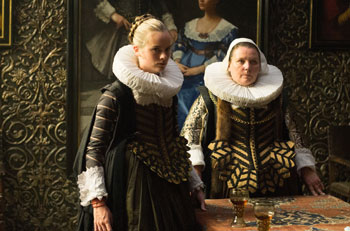 Chadwick was drawn to the story, but had some problems with the script until he persuaded writer, Tom Stoppard, to renew his involvement in the project. Describes Chadwick: 'The script was complicated and it took me a while to unravel. I think various people had come on board and they'd tried to rewrite it and do various drafts with other directors and writer director combinations that had fallen by the wayside, and it was a messy script. I asked Alison for a copy of the 2003 version, which was purely Tom Stoppard's version and immediately I could see how we could do it. I managed to get hold of Tom who'd not been involved in the project since it had fallen apart. I went to see him with my story boards and what I was thinking of doing with it and we went through the script page by page. I had the most amazing time with him exploring the kind of film that we wanted to make and what would be relevant now. That was the real start, the real drive that we had, then the blueprint came after we started to work together on the movie."
Chadwick was drawn to the story, but had some problems with the script until he persuaded writer, Tom Stoppard, to renew his involvement in the project. Describes Chadwick: 'The script was complicated and it took me a while to unravel. I think various people had come on board and they'd tried to rewrite it and do various drafts with other directors and writer director combinations that had fallen by the wayside, and it was a messy script. I asked Alison for a copy of the 2003 version, which was purely Tom Stoppard's version and immediately I could see how we could do it. I managed to get hold of Tom who'd not been involved in the project since it had fallen apart. I went to see him with my story boards and what I was thinking of doing with it and we went through the script page by page. I had the most amazing time with him exploring the kind of film that we wanted to make and what would be relevant now. That was the real start, the real drive that we had, then the blueprint came after we started to work together on the movie."
For Chadwick, it was of the utmost importance that the story feel relevant and the audience be enveloped in the action. He explains: 'I wanted to make a period movie feel visceral and emotional and just drop the audience in amongst the action. This isn't like a period movie that's set in a stately home; this is about working-class people and middle-class people. It was at a time when working class and middle-class traders could actually have vast wealth. They'd just newly discovered that the world was round. Ships were going around the world bringing cargo in from all over and they were questioning the presence of God and what that meant to them. There wasn't the class system that there is, or was, in this country. It was a really intoxicating time, where money was sloshing around."
For Dane DeHaan, it was not just the script but also the director that drew him in: 'The first time I talked with Justin, he talked about taking this heightened Tom Stoppard language and making it real and making it live in a way that hasn't really been done before, really grounding it in reality – and that's what I'm all about in my work. Justin's also such a passionate person, with this infectious energy and when he gets excited about something, you can't help but get excited about it as well."
Adds Alicia Vikander: 'Justin is very involved and really gives us a lot of his time and I've felt very safe. He's tough, which is good, and pushes the actors, so he's been very good to work with."
For Holliday Grainger who plays Maria: 'There's this swirl of tulip fever in the film and passion everywhere and laughing and gambling and drinking. I feel like the pace of the film is like a rolling ball down a hill that gathers momentum and just explodes at the end. Justin seems to have been completely affected by tulip fever. He's got this enthusiasm every day and just seemed excited to be on set and you can't help but be affected by that. He puts a lot of faith in you to do what you're doing and freedom to move around the sets. We had these lush sets to play with and wonderful props, which he really wants you to use, so you can always be in the moment and as truthful as possible."
Judi Dench agrees that Chadwick is a force of nature: 'He's absolutely a power of energy and enthusiasm and he gets everybody energized and says what he thinks and what he wants to get."
The Characters
Sophia Sandvoort
Chadwick had seen much of Alicia Vikander's previous work and was impressed by her talent. He explains: 'She's dynamic; strong; Yet she's vulnerable. She can play complicated characters and give complete honesty. And you know, in all the movies that she's done, she's been completely true. I talked to her about the film, and we really got on, and we both wanted the same thing for it. It's a complicated journey for her character, and in a way, I wanted Sophia to be played as a modern woman. At that particular moment in time, there was an enlightenment that was happening in Amsterdam, and there was equality between men and women, and it felt like we needed to have a strong, young actor playing that role, opposite Christoph. I loved her work and I loved her work ethic."
Vikander was at pains to ensure that her character had some integrity and was not a two-dimensional interpretation of a young flighty woman who would go off with the first handsome young man that she met. She explains: 'Cornelis is somebody that Sophia cares for a lot, shares a life with and with whom she is very much in love. When Jan first steps into her life she doesn't want to be part of anything with him, because she comes from a very Christian background and she has a husband that she loves and a life that she wouldn't just give away for something else. The love triangle is created because she is torn between the life she wants with Jan and the one she has. Even though she has love for Cornelis, she's a young woman who hasn't really experienced passion. I think everybody knows that the first time that happens, that you can't really control it."
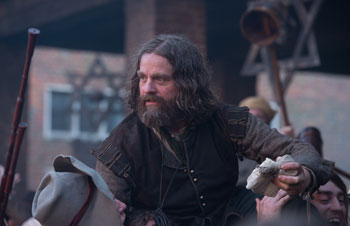 Adds Producer Alison Owen: 'I was always vehement about Sophia being very young because the plan itself is a bit crackpot, the product of a young girl's imagination. If it was an older woman that dreamt it, you would either think she was a bit stupid, or that it was too Machiavellian. It was essential to have the exuberance and the simplicity and innocence of a young girl who would really believe she was doing a good thing for everybody." She continues: 'It's a tough one, you want to catch somebody who is just on the rise and Alicia is breaking through to great things. She's an extraordinary actress."
Adds Producer Alison Owen: 'I was always vehement about Sophia being very young because the plan itself is a bit crackpot, the product of a young girl's imagination. If it was an older woman that dreamt it, you would either think she was a bit stupid, or that it was too Machiavellian. It was essential to have the exuberance and the simplicity and innocence of a young girl who would really believe she was doing a good thing for everybody." She continues: 'It's a tough one, you want to catch somebody who is just on the rise and Alicia is breaking through to great things. She's an extraordinary actress."
For Dane DeHaan, Vikander has the ability to bewitch, as he describes the moment that Jan meets Sophia for the first time: 'When Sophia walks down the stairs Jan is taken from the start by her beauty. He's very curious as to how she got herself in the position of being married to the older man. He has so many questions, but ultimately he's blown away by her beauty." He continues: 'De Bye [Kevin McKidd] is a very rich collector that Jan hopes to sell a painting to, but he tells Jan that his work is lacking obsession. Jan is really happy to drink a beer all day long and paint for as long as he can get by. When Sophia walks down the stairs, his obsession with her begins and he learns what it means to be obsessed. Sophia becomes the object of all of his paintings and he can't stop thinking about her, which fuels the passion and the love that he has for her and his need just to be with her."
Before he met Vikander, DeHaan watched some of her films and was immediately thrilled at the prospect of working with her: 'I watched -A Royal Affair' and it's just unbelievable how good she is. She's speaking all these different languages, but she is still so captivating and internally complex. She really is such a brilliant actress, that I was excited to work with her and discover who she was."
Vikander explains how important it was for her that she sat for the portrait of Sophia that was used in the film: 'I actually sat for a painter to make the portrait in the film and it is quite intense. In my job I look into people's eyes that I don't know that well, but when a painter looked at me, I got a bit scared because he was really trying to figure out who I am. The relationship between the painter and the person that gets painted is quite intense and I definitely brought that to the scenes with Dane. It really helped both of us to have that context to Jan painting Sophia. I think it really brought out the passion."
Jan Van Loos
Chadwick was also thrilled with the casting of Dane DeHaan: 'I'd seen Dane in independent movies, and loved the way he had an edge to him, and a romance to him. He hadn't played a leading man before, which was exciting for me, and to him. I thought there was something about Dane that could just capture that spirit and sensitivity of the artist, but also the danger for a man who was prepared to go to any length for somebody he loves, and the passion that he needed." Adds Alison Owen: 'Dane is so charismatic. When the camera's on him and he smiles, it feels like the sun's come out and you don't want to look anywhere else. He even pulls off the feat of looking very European and fits into the period very well with real grace and elegance." She continues: 'You really believe him as an artist, you can see he's interested and has that kind of mentality. The paintings were such a feature of this, that they had to be good and Dane had to feel realistic and credible as a painter."
DeHaan describes why Jan was an interesting character for him to play: 'Jan is very much a true hero. He's untroubled, just a hero that goes wholeheartedly at something in the name of love. I haven't really played a hero like that before."
Playing an artist convincingly was always going to be difficult and yet was an essential component for DeHaan to master in his need to make the experience as real as possible. To that end, he spent some time learning how to paint under the tutelage of artist Jamie Routley, whose portraits have been exhibited, amongst other places, at the National Portrait Gallery in the BP Portrait Award Exhibition and is the artist who painted the portraits used in the film. Explains DeHaan: 'I'm not a painter, and going into this I'd have given myself a third grade drawing level. Then I met Jamie, who trained in Florence in the seventeenth century style. He makes his own paints and paints as Jan would paint. Jamie was an amazing, invaluable resource because he gave me painting lessons and taught me how to make it look real."
He continues: 'A lot of times in movies, you see this really stereotypical movie version of a painter just standing in front of the painting at his easel. But that's not really how it was done. It was about stepping back and taking it in.
Everything you see in the movie is authentic to how these Dutch painters were probably painting. It was important for me to get that right and to get it accurately. I think I may be high school level at this point in my painting."
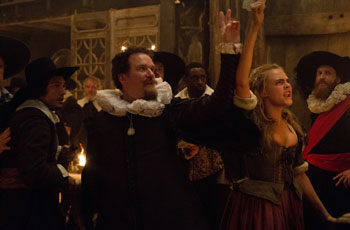 For Alicia Vikander, it was a pleasure to perform opposite DeHaan: 'He has such intensity to him, and he's a brilliant actor so I was very excited and happy when I knew we were going to do this together. That intensity that I'd seen before, he is really bringing to the character of Jan as well – and that is very sexy."
For Alicia Vikander, it was a pleasure to perform opposite DeHaan: 'He has such intensity to him, and he's a brilliant actor so I was very excited and happy when I knew we were going to do this together. That intensity that I'd seen before, he is really bringing to the character of Jan as well – and that is very sexy."
Adds Kevin McKidd, who plays Johan de Bye: 'He's a very committed serious young actor playing a young artist who's passionate about his work. Dane's instincts are bang on and he knows what he's after, but he's willing to try out other ideas. Sometimes, when you've got the pressure of being the lead actor I think it can shut you down a little bit and make people feel uptight, but he's very free and willing and wanting to play with all of us."
Cornelis Sandvoort
Justin Chadwick explains the casting of Christoph Waltz: 'Christoph was one of the first casting ideas for the film. The book hints at an older man, and the screenplay hinted at somebody much older. However, I felt that it was better to have somebody a little younger; a powerful man, a merchant, who had made his fortune, who was still alive and would add a dynamic to that relationship that was more complicated. Some people might watch the film and root for Cornelis, and that felt important and was a new way of thinking about that character. That really was the starting block, and once we got Christoph in, we could make Cornelis into a powerful man, not this doddery buffoon of a character, as was originally written, but a real force. That casting choice amped up the danger and it amped up the emotion of what Sophia was doing to him. Christoph is a master – he is a joy to work with, and we were very lucky that we were able to carve out some time with him, because he's such an important key role in the film. And just having him in there sets the tone. It's unexpected, and this cast is not what you thought it was going to be. It's not your usual British period drama. This is a much more exciting, dynamic, eclectic cast than was originally thought."
Adds Alison Owen: 'Christoph has made Cornelis a much more fully realised character than was originally anticipated. He has much more depth and is much less of a cuckold and a buffoon from that medieval renaissance tradition.
Christoph makes you feel everything that you need to really believe the plot. One thing that we needed that was a very hard balance to achieve was to make him feel kind enough that you would sympathize with him, yet not so kind that you wouldn't feel that Sophia had a good excuse to want to go and sleep with the painter. He needed to be dangerous enough that they would be a little bit scared of him and would want to leave. You have to have all of these qualities without one tipping over the other and Christoph is a perfect blend of them all – he really does make you feel sorry for him. He's a real man, a powerful man. You understand why Sophia would be drawn to a young guy of her own age, but you also understand why you wouldn't want Cornelis after you either. You can write those qualities in a book or script, but to actually show them is something else."
For Deborah Moggach, the writer of the novel Tulip Fever, on which the film is based, the casting of Christoph Waltz added a dimension to the story that she greatly appreciates: 'We've got a very stunning actor playing Cornelis, and that brings a whole new dynamic to that marriage. It makes it much more interesting because he's got a face which is filled with sorrow and depth; he's got huge nous to the way he acts. Christoph is a wonderful actor, but because he's so attractive and younger than I would have expected, it makes the dynamic between him and Sophia really interesting. We care about him much more. He's not just an old duffer blithering on about tulip bulbs and his business down in the docks. He's a man who's suffered hugely with the loss of his first wife. There's a relationship between them which is much more interesting and that was thrilling to see played out."
Dane DeHaan was interested in the juxtaposition of the characters of Cornelis and his own character explaining: 'I think Cornelis and Jan are polar opposites. Cornelis is the businessman, he's money minded and trying to take advantage of what's going on in Amsterdam at the time and really capitalize on the spice trade. He's all about making money for himself. Jan is the exact opposite. He wants to be able to express himself and he wants to create things and become a better artist and live that life. He's not so concerned about being rich; he really just wants to be able to get by and to continue to create. They really don't get along with each other from the start because Cornelis is there looking for answers and Jan is there wanting the process of painting the portrait to unfold in a natural way."
Vikander found working with Waltz very satisfying in that he was able to bring a lightness of touch to some very intense and emotional material. She explains: 'He brings a lot of humor to the screen, but also in real life too, so I had a lot of fun working with him. He was going off to another project so we did all of his scenes in the first three weeks and we got to work quite intensely together creating our characters. It was interesting to see how we were able to, hopefully, nail the humor that is needed in certain scenes and then still keep the authenticity of the emotions in other scenes which are heartbreaking. We've seen Christoph in a lot of big films where he's very funny, but it was nice to see him be so delicate in this film and emotional."
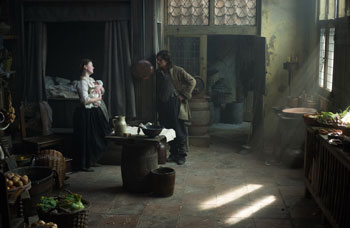 Maria and Willem
Maria and Willem
Says Chadwick: 'The heart of the film, for me, was Willem and Maria – the workers, the actual people that are making it happen. One is a fishmonger and one the maid of the house. It was important that they had a tangible chemistry together. Holliday Grainger and Jack O'Connell, from the moment you see them on camera, you just fall in love with them as a couple because they have that magic screen chemistry that rarely happens and they just completely physically connect. That gave us a real good heart and backbone for the film."
Holliday Grainger describes her character's love for Willem: 'Maria is a young maid to Sophia and Cornelis and is quite good friends with Sophia because they're of a similar age. She is head over heels in love with Willem and it's a lovely relationship in the script because it's a proper love. It's not the fevered romance of Jan and Sophia nor the sedate marriage that Cornelis and Sophia have. Their relationship feels quite modern in its trueness and it's quite tender, as well as being raunchy some of the time – she's a maid, he's a fisherman, they both want to roll around!" Adds Jack O'Connell, who plays Willem, on the subject of their love: 'It's a really uncensored, genuine, potent love between Willem and Maria. Their dreams have such a currency, that it's almost solidified."
Grainger was also interested in the connection between her character and Sophia: 'The relationship between Maria and Sophia has an interesting dynamic in that they're similar ages and they both come from poor working-class backgrounds, yet they've ended up in completely different places in life. There is a definite kind of maid-mistress relationship, but at the same time they become incredibly close through the pregnancy because they're relying on each other, both physically and mentally. Maria's got Sophia's future in her hands, and if it wasn't for Sophia's plan, Maria would be destitute and on the streets with a child. They've sacrificed a lot for each other and so there's this unspoken bond and appreciation which makes it really sad when eventually, after the drama of giving birth, they have to part forever."
Grainger also really enjoyed working with Jack O'Connell: 'We spent quite a lot of time in rehearsals hanging around and pretending to rehearse, which is always useful to get to know each other and find out where your dynamic sits. Jack is great to work with. We ended up improvising our first scene together and he's the best to improvise with. He's got such a strong instinct and hates it if it doesn't feel true and real."
For Jack O'Connell, Willem brought an important dynamic to the overall film. He explains: 'Willem's a working man. The cliché would be a sort of version of a working-class hero, but that doesn't write itself. The intention is that Willem is likeable. We like Willem, and we'll forgive him from time to time, hopefully. But within this storyline he represents, along with Maria, a lower social class than the one that Jan, Cornelis and Sophia would represent." He continues: 'He's a working man, he doesn't prioritize himself, he's very selfless, and these are traits that I really respect in people too. To be able to bring it into my work, I have to be thankful to the likes of Tom [Stoppard], to give me that sort of blueprint originally. In order to depict Amsterdam, I think we have to get an insight of almost the bottom of the pile. I guess Willem takes his own initiative in going and gambling on these tulips, and there's no guarantee for him. It's going to go either way for him, and it's all or nothing, so there's jeopardy in it, it's not an overnight decision."
For O'Connell, the contrast of Willem and Maria's lives with those of his employer adds an interesting juxtaposition to the narrative: 'In comparison to the aesthetic, this visual nature of what we're depicting the upper classes as being – the luxuries, the pleasantries, the shiny, spick and span clean nature – once you're in a sector that can't afford any of that, for me, in this story anyway, it shows a heightened version of everything that I think Jan and Sophia and Cornelis certainly want to achieve for themselves. Free of any greed are Willem and Maria, and that's why it was important for Holliday and I to make each other laugh on camera. We were able to improvise some stuff as well and get genuine laughter out of each other and seem totally happy with each other. I think that form of unity is a form of medication for the two of them. And I consider Willem a bit addicted to Maria."
Some Supporting Characters
Alongside the four main characters, there a host of interesting personalities who add richness to the story.
Zach Galifianakis plays Jan's manservant and friend Gerrit. Galifianakis explains: 'I was interested in it because the story was really great and the atmosphere in which it takes place. You do tend to look at all the elements when you're trying to figure out if you can do a job or not. The script, to me, was enough. But the fact that Justin was directing it and that there are these really legitimate actors as well helped too." In addition, Galifianakis had a soft spot for the character: 'Gerrit is the assistant to a struggling artist – he's a minion. He's not the brightest guy, but he's sweet."
For Alison Owen, the casting of Galifianakis could not have been better: 'Zach inhabits the character better than I could have dreamed of. When you've been with a piece of material for a long time, you have something very clear in your mind's eye; the bad part of film making is when the process falls short of your expectations. When I saw Zach perform in the role, he was so much better than I could have imagined."
Director Chadwick was thrilled when Dame Judi Dench took on the role of the Abbess, a new character introduced into the screenplay that was not in the original book. He explains: 'You've got this illegal tulip world that's happening in the backs of taverns, and you've got these orphanages full of children that have been left by the wars that happened, and the famines and the plague. We needed a character that would connect all these worlds, and Tom [Stoppard] wrote in the very final draft of the movie a character which bound them altogether – the Abbess, which is played by the beautiful Judi Dench. What a joy! It was a dream come true for all of us. Her energy was just extraordinary from the moment she arrives on set. It upped everybody's game, and fortunately, a lot of the young cast had the chance to do a scene with her and she was just electric." He continues: 'There's something that comes from her eyes that just connects with other human beings. She's tough in the film, but she does it with such truth and grace. It was an honor."
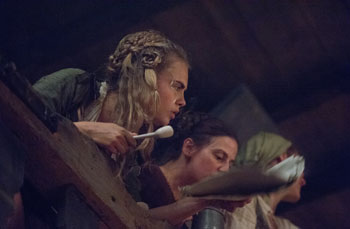 Dench describes her character thus: 'The Abbess grows a lot of tulips and knows everything about the bulbs, from the sizes and how to weigh them to the price of them. She enables the story to go ahead. She gets her hands dirty and is very hard working. They're all proper working nuns. She doesn't stand on ceremony, she's quite rude, and she smokes a pipe."
Dench describes her character thus: 'The Abbess grows a lot of tulips and knows everything about the bulbs, from the sizes and how to weigh them to the price of them. She enables the story to go ahead. She gets her hands dirty and is very hard working. They're all proper working nuns. She doesn't stand on ceremony, she's quite rude, and she smokes a pipe."
For Alison Owen, having Dench in the film was a coup: 'Whenever you watch a movie with Judi Dench in it, the excitement and the invigoration of the audience when she pops up is so palpable. When she's on screen it's like somebody making you sit up and take notice."
Matthew Morrison plays Mattheus, Jan's boisterous and fun-loving friend. As Morrison explains: 'Mattheus loves living. He loves booze, he loves art, and he loves women. He is really sophisticated, and I think he's bright, but he's a little lacking as an artist himself. He's gone as far as he can go, but he sees something in Jan that he's drawn to and he becomes good friends with him, and sees a great potential in him. He's a wheeler and dealer. He knows all the merchants, all the buyers and sellers, and the traders and he exploits his relationship with them."
He continues: 'You look at these costumes and think period piece, but it's really so current. We deal with this kind of stuff today in the stock market and it's this crazy world where they keep buying and buying and selling tulips and they keep increasing the prices of them. They think it's just going to go on forever and the reality is the bubble has to burst at some point. I think Mattheus is smart enough to know that that is going to happen and he's looking at everyone having so much fun and they're so drunk on the excitement of everyone around them, they don't quite see what is about to happen."
Tom Hollander plays Dr. Sorgh, who he explains is: 'An apothecary, a fertility doctor, who, as they don't have the right medicine in 1630, gets women pregnant by having sex with them. I think maybe he enjoyed it once upon a time, but now it's become burdensome and I think he'd quite like to be loved and not this seedy doctor." He continues: 'He is drawn into the deception plot of Sophia which all leads to the terrible tragedy for Cornelis, her husband, which Dr. Sorgh observes. He is both a comedy doctor, but also a compassionate man by the end of the story."
Yet another interesting supporting cast member is Kevin McKidd who plays Johan de Bye, who he describes as: 'A very well-heeled merchant, who has become a specialist in art dealing and becomes the benefactor of Jan. What I like about the character is that Justin [Chadwick] was adamant that he shouldn't be posh, just because he's rich, and he's somebody who's come up from the streets and made a lot of money."
For the artists' models in the film, present day models were cast, namely Cara Delevingne and Daisy Lowe. Delevingne explains that the models of that era were mainly prostitutes, but that her character, Annetje, was clever enough to take advantage of her situation: 'She's definitely a prostitute but she uses her worth. She steals money, she makes money, and she's a clever girl. In the tavern, she's got her blackboard up and is betting as well…She's not just selling her body; she's selling herself for a reason. I think women were not really respected in those times so she's clever and the men that know her respect her, so that's always good. I like to play strong characters, whether they're prostitutes or not. At least she's a strong one. She's a hustler. She's hustling. I think that's great."
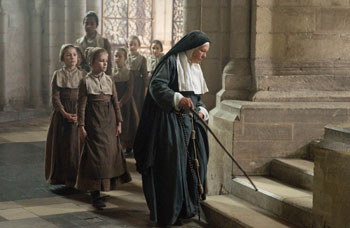 Tulip Mania
Tulip Mania
'Tulips then were new to Holland, and they were rare. To us the ultimate in Dutch domesticity, in the 1630s this fragile and changeable bloom represented novelty, unpredictability, excitement – a splash of the exotic east, a collector's item for the curious and the wealthy, rather than a simple and unpretentious flower in a jug on the kitchen table." - Anne Goldgar, Author of Tulipmania
Arriving from Constantinople to the Dutch United Provinces in the early seventeenth century, the tulip was considered to be a symbol of wealth and the ultimate in sophistication. With trade routes opening to the east and west of Europe, a privileged section of society emerged that had a disposable income to spend on ostentatious and beautiful objects including gardens and rare flowers, such as tulips. Indeed, many men and women of all classes now had a disposable income and enjoyed higher standards of living in comparison to other countries' standards of the era.
As time continued, the fascination with ever more rare varieties of the flower became a Dutch obsession and by 1636 they were being traded on the Amsterdam stock exchange.
By 1637, when the film is set, during this -Dutch Golden Age', Amsterdam was in a moment of great change. The Protestant Reformation had just taken place and the United Provinces were a great trading and shipping power around the globe. Amsterdam itself was very wealthy and cosmopolitan as well as a very liberal and free place to live.
In the 1630s, the Amsterdam stock exchange traded only between noon and 2pm and dealt in hundreds of commodities, although tulips were not amongst them. In time, the tulip traders found that meeting in back rooms of taverns served as a convenient meeting point.
There was a wide variety of bulbs on offer, from the cheapest single color variety up to the exquisite and delicately marked Semper Augustus tulip, which was very rare with perhaps a dozen blooms ever known to exist. Single bulbs of the Semper Augustus changed hands for twice the cost of a house.
To begin with, tulips were dealt by the bulb, and only in the summer season, but from the autumn of 1635, this changed when tulips which were still in the ground started to be traded. The bulb itself was now no longer the unit of currency, but it was rather a note promising the bulb to the buyer. These promissory notes meant that tulips could be traded through the winter months and that it was no longer tulip bulbs that were being traded, but notes about tulip bulbs that may not even have existed. This was the first futures market.
From December 1636 to January 1637 the tulip bulb craze reached its peak and could be said to have turned into a mania. However, by the first week of February the bottom had fallen out of the market and panic set in as traders realized that they had to sell as quickly as possible.
Despite attempts to regulate the market as everybody tried to sell commodities that they did not have, nor had they ever had, many of the tulip traders never recovered from the bust.
Tulip mania could be considered one of the earliest economic bubbles. It was a forerunner to the South Sea Bubble and all the other financial schemes that start with wild speculation and end with a crash of epic proportions.
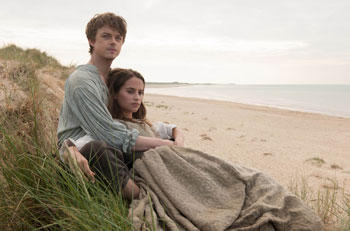 Research
Research
Tulipomania – Mike Dash – Indigo 1999
Tulipmania: Money, Honor, and Knowledge in the Dutch Golden Age – Anne
Goldgar – The University of Chicago Press 2007
Dutch Art – Inspiration and Execution
The writer of the novel Tulip Fever on which the film is based, Deborah Moggach describes how her interest in Dutch art inspired the work: 'Twenty years ago I went to a sale at Christie's because I'd seen this painting in the auction. I loved it to bits and I bought it. It's painted in 1630, I think, and it's of a woman getting ready to go out. She's wearing a little fur-trimmed velvet jacket, which was the fashion of the time, and she's looking out of the canvas at us with a rather enigmatic expression on her face. Her maidservant is bringing her a little pearl necklace to put around her neck and her manservant is bringing her a glass of wine. She's obviously quite pampered, quite rich, but her face was just enigmatic, and I thought, -She's up to no good; I wonder where she's going? Is she getting ready to go out? Is she going out somewhere she shouldn't be going out?" I hung the painting in my sitting room and gazed and gazed at it, and this story came to me.'"
Moggach continues: 'At the time I was living with a painter and he got very involved with the story too. As I was writing the book inspired by this painting, I was doing up the house that I'd bought for him and me to live in and he drew me drawings from Vermeer paintings, drawings to illustrate the book as I wrote it. He was also renovating the house like a Vermeer. We would build a fireplace that he'd copied from a 17th century Dutch painting. It was wildly romantic. We split up in the end, but it was lovely at the time."
Moggach was deeply affected by Dutch art of the time and explains: 'I wrote the book in this great fever of love – both for my partner but also for Dutch art, because they tell such stories. In this quiet domestic scene of this woman getting ready to go out there was a whole drama going on. I think in that short period in the 17th century, after paintings were religious in the 16th century and before the baroque period, these domestic paintings provided very thrilling narratives.
They're like film stills because you've got an arrested moment of drama and you feel if you blink, that woman is going to get up and move across the room, that man who's watching her as she's playing the virginal is going to move off with her, and the maid who is sweeping is going to run off with the servant. Those paintings tell us so much about normal life then and you feel like you are entering the household of these people and that's where the story was."
Production Designer Simon Elliott's inspiration for the film was Pieter de Hooch and Gabriel Metsu, which he explains are 'much richer and darker than people associate with the period. Most people think of Vermeer. He's very light and the walls are very light, but we wanted darker and shadier."
Adds Elliott: 'Obviously the paintings of the period are a huge inspiration. But when you start reading any of the historical documents you suddenly discover that these paintings are the biggest marketing campaign ever. They are the advertising of the period and were to show off artists' technical skills. They were meant to flatter the home owners of those patrons who commissioned the paintings, so they weren't exactly truthful. The light wasn't falling into those windows because the houses were so cram packed in the narrow streets. There weren't as many beautiful marble floors as people would not have been able to afford them – so there's a little bit of gloss in the paintings of the period. We took the essence of them and stripped them back, finding what we love about them and then trying to put something a bit more real on them."
The device within the film that draws Jan and Sophia together is the portrait commissioned by Cornelis. To that end it was essential to Simon Elliott to ensure that the finished painting would not be a disappointment. He explains: 'I came up with the idea of finding an artist whose style would lend itself to our movie without forcing them into painting in a style they didn't know or couldn't do. We hoped that with a little direction regarding background or props or costumes, we would end up with a painting that was more authentic." Elliott found Jamie Routley and hoped that 'the benefit of having him meant that we were able to capture the various stages of his pieces in the interim stages before the finished product. It was a new experience for the actors as they actually sat for him. They were sitting for a proper portrait rather than somebody in a dark room painting from some hurriedly taken snapshots. We were able to create a real painting and hopefully that will be conveyed on the screen."
He continues: 'You see the main portrait in about four states. There is the main canvas, prior to which, you see Jan's studies as he comes to the house to start his work. We've gone for the tradition of Frans Hals who painted larger canvases in the studio, and then when he came and saw his sitters in their home, he would do studies. In our story, Jan comes to the house and sketches Cornelis and Sophia. He does some head studies and then there are some interim stages plus some charcoal sketches before we start seeing the big portrait being painted."
For Producer Alison Owen: 'The genesis was very much in Dutch art and we wanted to convey that, but we didn't want it to be all about the art as this is a big story with big themes. We didn't want it to be static. It was very important to make it un-precious and very gritty and earthy. At the same time as we were invoking all those Flemish paintings and the Rembrandt and Vermeer, we were also relating it back to people's emotions and the present day as well. There's nothing static about the way we shot it. The camera's always moving and reminding us that these people are living and breathing and have emotions and feelings. I think that's the meeting of the cerebral, the Tom Stoppard adaptation and the instinctive, which is Justin's direction."
Adds Christoph Waltz: 'The past few years, I've developed a deep interest in Dutch and Flemish art of the 16th and 17th century. The art is beautiful and the paintings express not just what they show – they express what's behind what we see. They express a whole world, a whole era of civilization and humankind and spirit. That's why they are masters to a degree that is immense. You really feel, even if you don't quite fathom the depth of the painting, that there is something that you have to live up to. The challenge of looking at art from that period, or of great art altogether, is really that you have to widen your horizon. You are required to rise to the occasion and that effort is immensely gratifying."
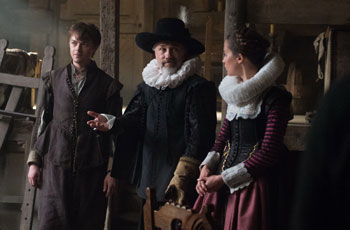 The Look of the Film
The Look of the Film
'Although we're making a period movie, we've approached it with a modern sensibility. It was really important to drop the audience and the actors in amongst it and have a 360° world. I didn't want us to be hamstrung with the fact that it's period, so I wanted a kind of real living, breathing world, that almost smelt real," describes Director, Justin Chadwick, who continues: 'There are only little areas of streets that have not been messed up by 21st century technology or modern buildings. It meant that we had to build a whole 360° world because I never wanted the camera to stop. I always wanted the camera to be on the move, to be in amongst the streets, following the characters. I felt that was important to understand this kind of breathless love story that Deborah [Moggach] and then Tom [Stoppard] had written, so we built it. That was a massive challenge actually to realize a 360° world that had scale."
Adds Director of Photography, Eigil Bryld: 'We try and keep the camera moving as much as possible just to be in amongst the action. We use a lot of hand-held and steadicam and we track a lot because we want to feel like the world is behind the camera as well." He continues: 'I think the real danger with any period film is that it becomes about the sets and the costumes – all the glory and the beauty. We have all of that in front of the camera, but we didn't want to treat it politely. We wanted to keep it very real and be in amongst it and have the drama unfold around us rather than in front of us."
Chadwick, who worked with Production Designer Simon Elliott a few years previously on -Bleak House' which was serialized for the BBC, explains: 'Simon is a very creative designer and has an amazing team that would be able to realise a great epic landscape. They built the whole world of the film and we even ended up building a canal. The film really drops the audience right in it and we were able to move the camera through the worlds of that team's imagination." The Amsterdam of the 1630s was quite small and as Simon Elliott explains: 'It's quite rough and hasn't had its huge makeover. It was a quagmire, a foul cesspool. It was a swamp on the edge of nothing. There are lots of descriptions of it being very dirty, very infested. They only got over the Plague eight years earlier, so there are a lot of contributing factors to why it feels very claustrophobic and very dirty at this period. Although Dutch housewives are famous for keeping their homes very clean, beyond their front door was a kind of festering swamp."
Adds Dane DeHaan: 'The more real that things can be, the more it helps because I have to create a fully realized world for the way that I work. They've built some really incredible sets and then packed them with extras and eels and pigs that make it feel like a fully realized world and which certainly makes my job easier."
For actor Tom Hollander: 'These crafts are just staggering; the most fun thing is walking into a studio and seeing all that production design and all that brilliance, the detail and artistry that is just brilliant. There are so many hundreds of people crawling over the organism of the set and making it alive. You walk in through a slightly drab corridor and you're in Amsterdam in 1630. When it's looked at through a camera with smoke and light it looks amazing. It's magical."
The Sandvoort house set at Pinewood Studios was constructed as a stand alone building on two floors. Explains Director of Photography Eigil Bryld: 'The route we could have chosen was to build each room separately so we could take walls out, but right from the beginning we wanted to be able to move from room to room. We wanted to be able to move from the exterior to the interior seamlessly and without having to cut around it. It made it difficult in some ways as you can't move a wall as there's another room behind it. Also, it's on two stories so we could bring people up and down the stairs. In terms of logistics it's been a bit of puzzle, but I think it really adds to the sense of actually being there and being able to move freely around." He adds: 'Simon Elliott's design is really built up in layers and then you try and have a symphony of textures and different qualities of light. It brings it all to life and it's more than just a pretty image."
For Production Designer Simon Elliott: 'The Sandvoort House is an exaggeration of houses from the period, which were very narrow with limited frontage onto whichever street they were on. They went back a very long way and usually had some sort of yard at the back. What we had to do was make it a little bigger otherwise it wouldn't have been practical to shoot in. The problem with having something that's long and narrow is how you get natural light into the middle of the set. We moved what would be a back yard into the middle of the house and made a central courtyard. The house wraps itself around this central courtyard which enabled Eigil to have daylight streaming into the three central rooms. We're lit from the street side and then also from the central courtyard."
Describing the architecture of the house, Elliott continues: 'The front hallway is the public space of a Dutch house – it's where the master of the house would do his meeting and greeting and do any business transactions. Then you move through to a more private space ending up with the kitchens at the back of the house. Then we facilitate a suite of bedrooms above which are accessed through two staircases which are practical."
Eigil Bryld explains that: 'We wanted to try and stay true to the nature of what it was like living back then, and candles were expensive, so you would have very few of them. So, if you had to do something during the day that required light, you'd do it by the window. We're not making a documentary, but it informs the actors where and how to move in the room and grounds the film in a reality."
Bryld continues on the theme of light: 'Most of the interiors are quite dark and it's very rich in terms of texture. One unusual thing is that we have very high windows with shutters below, which creates a very steep light that falls in and automatically gives it quite a painterly look. It's not something that we strive towards, but rather because we're being true to the elements. It's more about contrast and the color of the light."
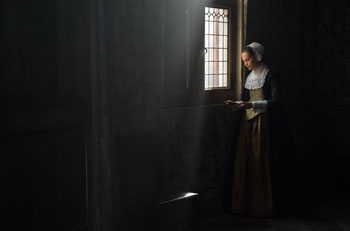 Locations
Locations
Almost all of the interiors of the film, the Sandvoort House, the interior of the tavern and Jan's studio were shot at Pinewood Studios. While Tulip Fever is set in Amsterdam, Production Designer Simon Elliott explains why the exteriors for the film were also all shot in the UK: 'Financial implications are always a huge impact when you're doing a film of this nature, so that was a consideration, but also, what is left from 17th Century Amsterdam is few and far between. There are little pockets of it, but Amsterdam today is built of many layers of history. To strip all that back and try to reinstate the period in which the story is set wasn't going to work for us."
Adds Eigil Bryld: 'It's hard to design a movie like this because there is not much unspoiled architecture from this period in the UK. It's very easy to get cornered in and see very little. We tried hard to find locations and create environments where we could see 360° and move the camera freely. We didn't ever want to have a feeling that people were backed up against something or that we couldn't be in amongst it and actually be in the emotions and the drama and humor."
Director Justin Chadwick and Designer Simon Elliott had worked together at Cobham Hall in Kent ten years earlier on the television series -Bleak House'. Elliott explains why he returned: 'I have looked at every red brick Tudor mansion up and down the country. I had this crazy notion that I needed to graft a set onto an existing building so that we could get double the set for our money. What's interesting about Cobham is that one face of it is 250 feet long straight, so I thought it would be the perfect place to graft a canal. That's how the canal was born. It gave me the perfect façade because of the nature of the architecture. It's a raised ground floor with a terrace from which I was then able to build out to build the canal." He continues: 'It's actually a very simple idea to a problem we had, that rather than excavating tons and tons of earth we just built up – it's all scaffolding and plaster brick."
Camilla Stephenson, Supervising Location Manager adds: 'Cobham was the big find as there are a limited amount of properties that would work for the period and the style. When Simon [Elliott] saw the amazing length of the building he knew he could create a long street, typical of Amsterdam. He then came up with this magical idea of creating a canal here, and therefore Cobham Hall won the battle over all the others that we looked at." She continues: 'Simon's fantastic idea was that we would never try and dig a canal, we would build upwards from the road, so what is, effectively, the first floor of a building is our ground floor." The build took ten weeks.
For Alicia Vikander working on the Cobham set was a treat: 'They built this whole canal and three bridges and put in boats, and then there are eel smoking houses which are actually real and the butcher's house and all the things that are sold in the market, which are real. There were real pigs' heads and meat carcasses and masses of extras, children and musicians playing – I was just quite amazed and I just stood and watched for an hour. I was so happy I was not in the first scenes so that I could just walk around and get a feel for it."
The Market Square was also filmed at Cobham Hall.
The production also travelled to Norfolk to film various scenes including some on the beach at Holkham and the St. Ursula's Convent scenes at Norwich Cathedral. Explains Camilla Stephenson: 'My brief was to find the biggest cloister in the country and as far as I know, Norwich is the biggest so it fit perfectly. When you look at some of the paintings of the period you will see large churches and cathedrals in that stone with the same look and size and grandeur of Norwich Cathedral."
Adds actor Judi Dench: 'The cloisters are so beautiful and so is the light within them. In the middle of the cloisters the brilliant art department have built this wonderful garden that the nuns work in with wicker part tiers and everything is really growing. I don't know how they do it. It looks completely real. It's a proper working garden and it's lovely. I'm also acting with four big black pigs, two short horn cows, some warren hens, and twelve geese. Not only do you get to work with some cracking actors, you get to work with some cracking animals too."
Another challenge for Camilla Stephenson was finding a location for the dock scenes, finally settling on Tilbury Docks in Essex. She explains: 'Docks didn't look like they do now. We were very keen not to have a harbor to represent the Amsterdam Docks because that isn't correct for the period. Amsterdam would have had lots of small boats and the large boats would be out in the estuary or at sea and things would be transferred to smaller boats to come in to land. In seventeenth century Amsterdam, there were 5,000 boats docking a day. It must have been an incredible place, so we thought it would be lovely to see some more water and a bridge and a way into the city. In the end that is what we tried to create at Tilbury, a contrast to our market streets, and we got to use an amazing bridge that works perfectly for our period."
Other locations included the exterior of Jan's studio which was recreated in Charterhouse Square, City of London and the exterior and some interiors of the tavern, which were shot at Kentwell Hall, Suffolk.
Tulip Fever
Release Date: November 23rd, 2017
MORE





